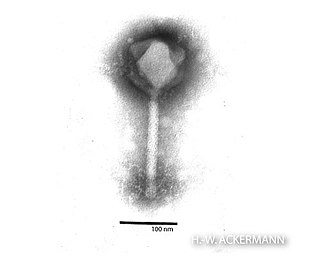Hpunavirus is a genus of viruses in the family Myoviridae, within the subfamily Peduovirinae. Bacteria serve as the natural host, with transmission achieved through passive diffusion. There are two species in this genus.
Peduovirus is a genus of viruses in the order Caudovirales, in the family Myoviridae, in the subfamily Peduovirinae. Bacteria serve as natural hosts, with transmission achieved through passive diffusion. There are 15 species in this genus.
Twortvirus is a genus of viruses in the order Caudovirales, in the family Herelleviridae, in the subfamily Twortvirinae. Bacteria serve as natural hosts. There is only one species in this genus: Staphylococcus virus Twort.

Schizotequatrovirus is a genus of viruses in the order Caudovirales, in the family Myoviridae, in the subfamily Tevenvirinae. Bacteria serve as natural hosts. There are three species in this genus.
Bcepmuvirus is a genus of viruses in the family Myoviridae, not assigned to a subfamily. Bacteria serve as the natural host, with transmission achieved through passive diffusion. There are two species in this genus.
Felixounavirus is a genus of viruses in the order Caudovirales, in the family Myoviridae. Bacteria serve as natural hosts, with transmission achieved through passive diffusion. There are currently 16 species in this genus, including the type species Salmonella virus FelixO1.
Hapunavirus is a genus of viruses in the family Myoviridae, not assigned to a subfamily. Bacteria serve as the natural host, with transmission achieved through passive diffusion. There are two species in this genus.
Bixzunavirus is a genus of viruses in the order Caudovirales, in the family Myoviridae. Bacteria serve as natural hosts, with transmission achieved through passive diffusion. There are eight species in this genus.
Muvirus is a genus of viruses in the order Caudovirales, in the family Myoviridae. Bacteria serve as natural hosts, with transmission achieved through passive diffusion. There are two species in this genus.
Pbunavirus is a genus of viruses in the order Caudovirales, in the family Myoviridae. Bacteria serve as natural hosts. There are 27 species in this genus.
Lubbockvirus is a genus of viruses in the family Myoviridae, not assigned to a subfamily. Bacteria serve as the natural host, with transmission achieved through passive diffusion. There are two species in this genus.

Phikzvirus is a genus of viruses in the order Caudovirales, in the family Myoviridae. Bacteria serve as natural hosts. There are three species in this genus.
Zindervirus is a genus of viruses in the family Autographiviridae, within the subfamily Molineuxvirinae. Bacteria serve as the natural host, with transmission achieved through passive diffusion. There are currently three species in this genus, including the type species Salmonella virus SP6.

Teseptimavirus is a genus of viruses in the order Caudovirales, in the family Autographiviridae, in the subfamily Studiervirinae. Bacteria serve as the natural host, with transmission achieved through passive diffusion. There are currently 17 species in this genus, including the type species Escherichia virus T7.
Rosenblumvirus is a genus of viruses in the order Caudovirales, in the family Podoviridae, in the subfamily Picovirinae. Gram positive bacteria serve as natural hosts, with transmission achieved through passive diffusion. There are currently 12 species in this genus, including the type species Staphylococcus virus 44AHJD.
Salasvirus is a genus of viruses in the order Caudovirales, in the family Podoviridae, in the subfamily Picovirinae. Bacteria serve as natural hosts. There are currently four species in this genus, including the type species Bacillus virus phi29.
Ravinvirus is a genus of viruses in the order Caudovirales, in the family Siphoviridae. Bacteria serve as natural hosts, with transmission achieved through passive diffusion. There is currently only one species in this genus: the type species Escherichia virus N15.
Lomovskayavirus is a genus of viruses in the order Caudovirales, in the family Siphoviridae. Bacteria serve as natural hosts. There are currently two species in this genus including the type species Streptomyces virus phiC31.
Spbetavirus is a genus of viruses in the order Caudovirales, in the family Siphoviridae. Bacteria serve as natural hosts. There is currently only one species in this genus: the type species Bacillus virus SPbeta.
Tunavirus is a genus of viruses in the order Caudovirales, in the family Drexlerviridae. Bacteria serve as natural hosts. There are currently 14 species in this genus, including the type species Escherichia virus T1.


